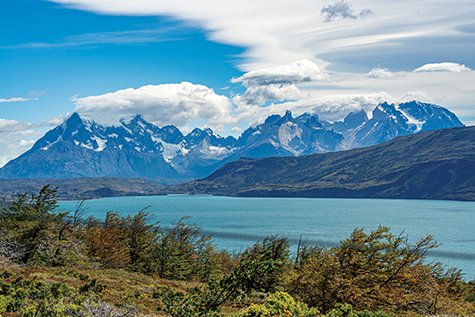ARTIST PROFILE

To the Ends of the Earth
Island Photographer and Adventurer Doug Burke Takes on Patagonia and Antartica
By Amelia Smith
For Doug Burke, photography and wilderness travel are lifelong passions, and those came together this winter in a long-anticipated journey to Patagonia and Antarctica. Along the way, he found stunning wildlife, spectacular scenery, and unparalleled adventure. One morning in 2022, Doug opened his email to this message from his friend Glen: “Photography trip, Antarctica 2024: Sign up now!” Doug didn’t hesitate to tell Glen he was signing up. He and Glen had met through work, and their friendship developed over the course of many trips, first to Iceland, then to Iceland again, to Death Valley, and to Kanab, Utah.
Doug grew up in Manhattan, but he’s not the city type. “As a young person growing up in New York City in the 1970s, there were a lot of distractions,” he says. He always had a sense for adventure, whether in the city or exploring the wild. “I had a tremendous science teacher who was the head of photography at my school,” Doug says. “I learned the whole process, shooting, developing, printing, and enlargement in black & white and color.” He pursued that passion through high school, working on the yearbook and documenting family trips. Later, Doug passed his passion for photography on to his son Jonathan. Every year, he used to take his son to national parks for a few weeks and they took lots of photographs. Now, Jonathan is a professional photographer for the University of Houston.
Doug’s college education progressed in fits and starts – he graduated from the third college he attended. He worked as a chef for a while before getting into a career as sales director for EMC2/Dell Technologies which lasted until August of 2023. He continued to take photographs, but his enthusiasm for photography was renewed when he took a week-long class from Alison Shaw in 2014. That class catapulted him to the next level in his craft, and he started selling prints to his friends at work and online. “I was always enamored with photography,” Doug says. “I love nature and capturing all its beauty.” When he’s looking through the lens, he says, the world just melts away. Doug loves the beauty of the Vineyard, and the lively culture here. You can find him out with his camera on the coastline at 5AM, or on his bike with the Cycling Club of Martha’s Vineyard.
Doug Burke had always wanted to see the legendary landscape of Patagonia, as well as Antarctica. He and Glen added Patagonia to their Antarctic expedition, and on February 6th this year they finally set off. They flew to Santiago, grabbed a hotel room for the layover and explored the city. The hotel was completely protected by steel bars, which made for an eerie beginning of the trip. In the wee hours of the next morning, Doug and Glen made their way back to the airport and the flight to Punta Arenas, a city near the southern tip of Patagonia, on the Strait of Magellan. “The airport was packed and no one spoke English. Thank goodness for Google Translator,” Doug says. “We had 2 hours to check in and catch a flight. The flight finally showed up on the board, but it said, ‘3 minutes,’ not a gate. I realized all of a sudden it was like Penn Station in NYC with Amtrak, where they tell you what gate to show up at for your train in a short amount of time. The gate shows up, and no one can tell us where the gate is, as it is not on the terminal map. Nerves set in. Along the way my ticket and pesos were falling out of my back pocket. It served as constant entertainment amidst the nerve-wracking situation.”
Punta Arenas is the hopping off point for travels to the surrounding national parks as well as for trips to Antarctica. Doug and Glen picked up a rental car – standard transmission – and headed out to the park, where they would have no wifi for a week, and there were no gas stations. They brought an inflatable 2-gallon gas tank which came in handy. Doug relished the prospect of being out of touch and in the wilderness. They arrived at Lake Pehoé Hotel and enjoyed a good dinner before a short night’s sleep, waking up 2:30 AM to make a sunrise climb on the Mirrador Base Las Torres hike, one of the most spectacular hikes in the world. They climbed the rocky slopes in the dark. “I had been dreaming about this since my late 20s,” Doug says, “to come down here and hike up.” The last 1000 feet was literally straight up, and climbing over boulders was a challenge. He waited for Glen to catch up so that they could experience the moment together. It was a dream come true for Doug. “Glen and I hung out for a while just taking it all in.”
On February 18th, twelve days after leaving the Vineyard, Doug and Glen boarded a plane to King George Island with their fellow passengers for the Antarctic expedition on a cruise ship specially designed to handle challenges of the Southern Ocean. The ship used Zodiac boats to take passengers ashore, where strict rules were enforced to protect the environment.
The first morning out was magical. It was in the low 30s, sunny with clouds and blue sky. Pods of Orcas were off the port side and humpback whales were breaching off the bow. “The pristine beauty of Antarctica hasn’t changed,” Doug says. “You can’t kneel or put things down, it’s like no one has ever been there before.” There were mountains of rock, glaciers, icebergs, and of course the wildlife. On shore the first day, it was cold, misty, and snowy. The passengers were ordered to stay 15 feet away from the penguins, 25 feet from the seals.
Doug caught some spectacular images, but he really had to learn to use all the functions of his camera to compensate for not being able to use a tripod, or even crouch down. This meant having pre-programmed settings for Aperture and or Shutter mode with Auto Focus on. One challenge came when all the passengers were crowded along the rail of the ship to photograph a whale through snowy weather. The camera’s auto-focus locked in on the falling snowflakes, leaving the whale’s tail blurry in the background. Doug had to quickly learn to approach it in a new way, and finally got the image he wanted of the whale’s tail.
In Antarctica, safety measures are essential. Each time passengers from the ship went ashore, an extra Zodiac came along loaded with 36 hours of provisions in case the shore parties were cut off from the ship. Navigation could be challenging, too. One afternoon, Doug, Glen, and two other passengers were in a Zodiac with a guide from the Faroe Islands. The fog rolled in, and in the low visibility the guide took a wrong turn. Doug realized what had happened. “It would be like being off South Beach and the fog rolls in, and not being able to see land and going away from land when the whole time you thought you were going to the beach,” Doug wrote in his journal. “The walkie talkie was going full blast with, ‘we see you are not in the right location, please get back on path.’” Luckily, the guide was able to use the GPS on her Garmin watch to retrace their steps, and they were only delayed by ten minutes. They were also equipped with beacons, yet another safeguard in place against potentially tragic mistakes.
Another activity on the trip was the polar plunge off the ship into the Antarctic waters, with music and shots of vodka afterwards to those who took the plunge. “When your body hits the water, it is as though there are needles just pulsating into your body and you go numb, not numb enough not to realize you need to get out quickly,” Doug said. The trip offered a great experience, but Doug’s final days on the ship were marred by illness – he was confined to his cabin as the ship made its way back across the Drake Passage, which they had flown over on the way down.
They docked in Puerto Williams, the southernmost city in South America, then flew back to Punta Arenas and took a final hike around the city before heading home. It was an occasion for reflec-tion. “As I get older in life I feel this nagging sense of a red light coming from a lighthouse off in the distance, it is always there,” Doug wrote. “My view it is getting closer not further away, one cannot tack away from it. There are times when the seas are calm and the sun is out, but it is still there. As you ebb closer you realize there are only so many tacks left at the helm. One needs to ride the current to the edge on each tack til’ there is no more wind and enjoy the white caps that are thrown at you or the rollers you glide over. At the end of one day, you will land at the base of the lighthouse and the sunset will radiate around the world to all who have loved you.”
When he’s not on the road, Doug lives with his wife Deb on the Island as he pursues his new career with Cronig’s Real Estate as a sales agent, and he also drives for Resort Man Tours. Still, the next adventure is always just around the corner.
To see more of Doug’s work, check out his Instagram page:@DougBurkePhotography, or see his website at dougburkephotography.net, DPBPhotography2024@gmail.com








